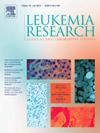来那度胺联合硼替佐米治疗同种异体干细胞移植后复发的急性髓系白血病或骨髓增生异常综合征的I期临床试验
IF 2.1
4区 医学
Q3 HEMATOLOGY
引用次数: 0
摘要
同种异体造血细胞移植(HCT)可以改善MDS或AML患者的长期生存,但HCT后疾病复发很常见,后续治疗选择有限,复发后预后极差。来那度胺和硼替佐米在这种情况下可以发挥抗增殖作用,增强移植物抗白血病免疫反应,并增强化疗药物。目的评价硼替佐米联合大剂量来那度胺治疗HCT后AML或MDS复发患者的安全性和初步疗效。研究设计我们进行了一项I期、剂量递增、多中心研究,将硼替佐米与大剂量来那度胺联合应用于HCT后复发的AML或MDS患者。我们招募了移植后复发性或进行性AML或MDS的成年患者;患者被要求停止全身免疫抑制,无GVHD证据,器官功能正常。在每个周期的第2、5、9和12天给予递增剂量的硼替佐米,而来那度胺在28天周期的第1-21天给予50 mg /天。在诱导的前2个周期评估dlt,并在此期间评估反应。在达到治疗反应后,患者可以继续维持剂量。主要终点是毒性和确定联合的最大耐受剂量(MTD),而次要终点包括反应率和反应持续时间。结果21例患者入组,中位年龄66岁(范围23-74)。大多数入组患者患有AML(19/21)。3例患者入组,硼替佐米剂量分别为0.7 mg/m2、1.0 mg/m2和1.3 mg/m2。一名患者在1.3 mg/m2时出现剂量限制性毒性(接受50% %剂量),该队列扩大到6名患者,将其确定为推荐的第二阶段剂量(RP2D);未达到最大耐受剂量(MTD)。另外9名扩展患者以该剂量水平治疗,总共15名患者接受来那度胺50 mg和硼替佐米1.3 mg/m2的治疗。在剂量扩大期间,由研究药物引起的4级毒性包括4级中性粒细胞减少(n = 5)、血小板减少(n = 3)和发热性中性粒细胞减少(n = 1)。在所有队列中(n = 21),1例患者(4.8 %)达到CR, 3例患者(14.3 %)达到CRi(复合CR/CRi率为19 %)。在RP2D治疗的15例患者中,4例患者在第一个诱导周期后病情进展,2例患者在诱导周期2停止治疗。共有9例患者完成了两个诱导周期。在RP2D治疗的15例患者中,1例达到CR, 2例达到CRi(复合CR/CRi 20 %,CI 5.7-44.0 %),4例病情稳定。治疗期间的嵌合现象通常与疾病反应有关,一名持续低嵌合的患者也实现了CRi。获得CR的单个患者携带NPM1基因突变。在接受测试的13名患者中,共有3名患者携带TP53基因突变,其中2名患者在研究开始前接受DLI治疗后达到CRi。结论硼替佐米可联合来那度胺治疗HCT后复发的AML和MDS患者,总缓解率为19. %。毒性是可控的,主要与诱导期间的细胞减少有关。有反应的患者包括1名npm1突变的AML患者和2名TP53基因突变的患者,这表明在高危疾病中可能有治疗益处。硼替佐米和来那度胺可以在供体淋巴细胞输注后安全使用,没有移植物失败或免疫相关毒性的证据。本文章由计算机程序翻译,如有差异,请以英文原文为准。
A phase I clinical trial of lenalidomide combined with bortezomib for acute myeloid leukemia or myelodysplastic syndrome relapsing after allogeneic stem cell transplantation
Background
Allogeneic hematopoietic cell transplantation (HCT) may improve long-term survival in patients with MDS or AML but disease relapse following HCT is common, with limited subsequent treatment options and extremely poor post-relapse outcomes. Lenalidomide and bortezomib are therapies which, in this setting, may exert antiproliferative effects, enhance graft-vs-leukemia immune responses, and potentiate chemotherapeutic drugs.
Objectives
We sought to evaluate the safety and preliminary efficacy of bortezomib in combination with high dose lenalidomide in patients with AML or MDS relapsing after HCT.
Study design
We conducted a phase I, dose-escalation, multi-center study of bortezomib added to high dose lenalidomide in patients with AML or MDS relapsing after HCT. We enrolled adult patients with recurrent or progressive AML or MDS after transplant; patients were required to be off systemic immunosuppression, with no evidence of GVHD, and with adequate organ function. Escalating doses of bortezomib were administered on days 2, 5, 9, and 12 of each cycle, while lenalidomide was given at 50 mg daily on days 1–21 of a 28-day cycle. DLTs were assessed during the first 2 cycles of induction and responses were assessed within this period. After achieving a treatment response, patients could proceed to maintenance dosing. The primary endpoint was toxicity and to establish the maximally tolerated dose (MTD) of the combination, while secondary endpoints included response rate and duration of responses.
Results
21 patients were enrolled, with a median age of 66 years (range 23–74). The majority of patients enrolled had AML (19/21). Three patients were enrolled at each bortezomib dose level of 0.7 mg/m2, 1.0 mg/m2 and 1.3 mg/m2. One patient experienced dose-limiting toxicity at 1.3 mg/m2 (received <50 % doses) and the cohort was expanded to 6 total patients, establishing this as the recommended phase two dose (RP2D); a maximum tolerated dose (MTD) was not reached. An additional 9 expansion patients were treated at this dose level for a total of 15 patients treated with lenalidomide 50 mg and bortezomib 1.3 mg/m2. During dose expansion, grade 4 toxicities attributed to study drug included grade 4 neutropenia (n = 5), thrombocytopenia (n = 3), and febrile neutropenia (n = 1). Across all cohorts (n = 21), 1 patient (4.8 %) achieved CR and 3 patients (14.3 %) achieved CRi (composite CR/CRi rate of 19 %). Of the 15 patients treated at the RP2D, 4 patients had progressive disease after the first induction cycle, and 2 patients stopped therapy during induction cycle 2. A total of 9 patients completed both induction cycles. Of the 15 patients treated at the RP2D, 1 achieved CR, 2 achieved CRi (composite CR/CRi 20 %, CI 5.7–44.0 %) and 4 patients had stable disease. Chimerism during treatment generally tracked with disease response and one patient with persistent low chimerism also achieved CRi. The single patient achieving CR harbored an NPM1 gene mutation. A total of 3 out of 13 patients tested harbored a TP53 gene mutation and 2 of these patients achieved CRi on study subsequent to receiving DLI before study entry.
Conclusions
Bortezomib can be combined with lenalidomide in patients with AML and MDS relapsing after HCT with overall 19 % of patients achieving composite remission. Toxicity was manageable and primarily related to cytopenias during induction. Responding patients included 1 with NPM1-mutated AML as well as 2 harboring TP53 gene mutations, suggesting possible therapeutic benefit in very high-risk disease. Bortezomib and lenalidomide could be safely used following donor lymphocyte infusion without evidence of graft failure or immune-related toxicity.
求助全文
通过发布文献求助,成功后即可免费获取论文全文。
去求助
来源期刊

Leukemia research
医学-血液学
CiteScore
4.00
自引率
3.70%
发文量
259
审稿时长
1 months
期刊介绍:
Leukemia Research an international journal which brings comprehensive and current information to all health care professionals involved in basic and applied clinical research in hematological malignancies. The editors encourage the submission of articles relevant to hematological malignancies. The Journal scope includes reporting studies of cellular and molecular biology, genetics, immunology, epidemiology, clinical evaluation, and therapy of these diseases.
 求助内容:
求助内容: 应助结果提醒方式:
应助结果提醒方式:


